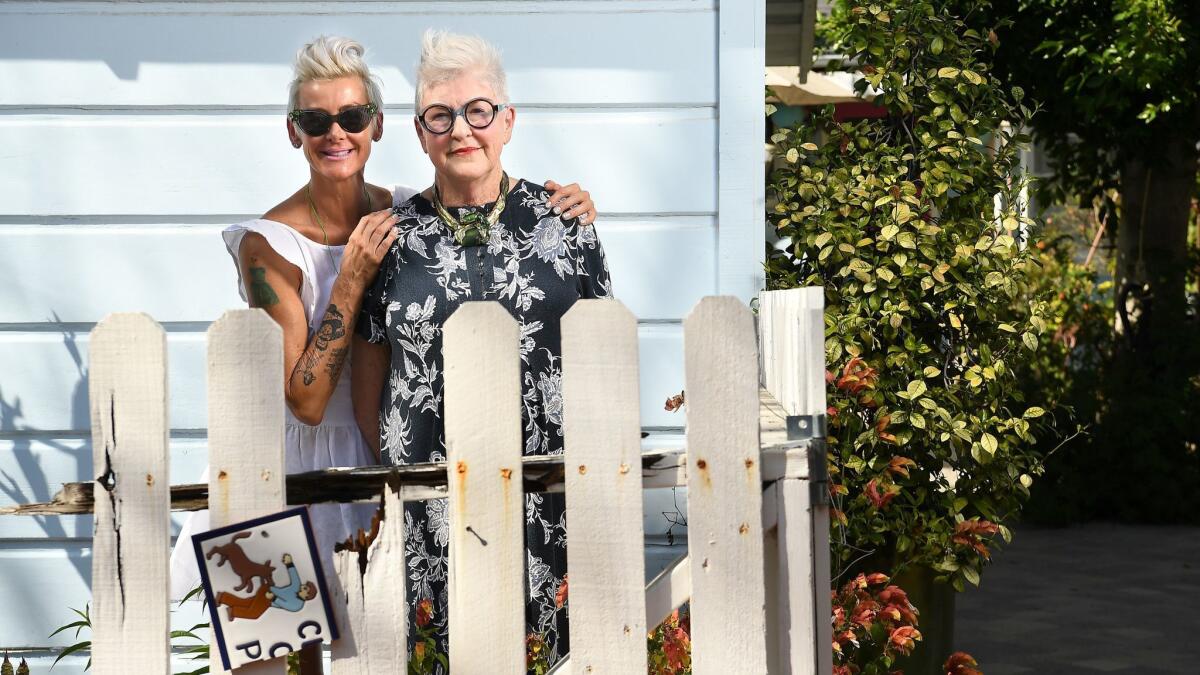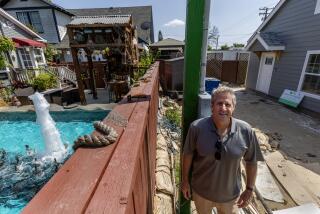Could granny flats help ease the state’s housing crisis? Some advocates think so

Several years ago, Patsy Spitta of Altadena wanted to help her daughter afford a home — something out of reach for many teachers like her daughter.
So Spitta, still working as a paralegal in her retirement years, had an idea.
She would build a backyard house and live there, allowing her daughter and grandson to leave their $2,500-a-month apartment and move into the two-bedroom house Spitta purchased three decades ago.
The only problem? A series of municipal regulations made the project infeasible.
“Then,” Spitta said, “the rules changed.”
Specifically, a series of state laws took effect last year that seek to ease California’s housing shortage by eliminating local restrictions that made it difficult or impossible to build such small second homes, commonly known as granny flats.
Now, the 77-year-old grandmother is among a wave of Californians building second homes in their backyards, getting their previously illegal units permitted and converting their garages to rent to family or others.
“I got over 200 names on an interest list,” said John Arendsen, a veteran contractor who started marketing his Vista company as Crest Backyard Homes last year because of the eased rules. “I have changed my whole business model.”
Housing advocates say barriers to construction remain, but they are praising the changes, noting the laws opened a crack in a fiercely protected single-family zoning code that limits how many homes can be built on a lot in large swaths of the Golden State.
“It’s the first time in decades we can [really] do more than one” home on a lot, said Mark Vallianatos, policy director for advocacy group Abundant Housing L.A.
In Oakland, the planning department approved 266 so-called accessory dwelling units (ADUs) in 2017, up from 126 a year earlier.
In Long Beach, 96 applications are pending and the city has approved 15 this year, compared with 21 approved in all of 2017 and none a year earlier. Increases also have been reported in San Diego, San Jose and San Francisco.
The largest growth is in Los Angeles, where 2,342 secondary units were permitted in 2017, up from 120 in 2016.
Though many individual homeowners are jumping at the chance to add granny flats to their properties, the change hasn’t been universally welcomed by homeowner groups.
“There is a new ADU being built on every block in this neighborhood,” said Elizabeth Pollock, president of the Del Rey Residents Assn. who wants the city to crack down. “Every time you add people to a neighborhood, you add a need for city services and a need for parking and all the things that come with added density.”
It’s not clear how much of L.A.’s massive increase comes from homeowners legalizing backyard homes that were illegally built without permits, rather than from building new units that would add to the city’s housing supply.
The city issued 306 permits last year for new, free-standing secondary dwelling units. But it’s hard to tell whether the remaining permits for structure conversions or additions are for existing, residential units that are currently illegal. The question isn’t asked and homeowners aren’t particularly forthcoming with such information, a Building and Safety spokesman said.
Ira Belgrade, a backyard home advocate who for a fee helps homeowners permit secondary units, said he’s seeing a surge of people interested in legalizing their units.
“They are coming out of the woodwork,” he said.
David Garcia, policy director for the Terner Center for Housing Innovation at UC Berkeley, said that legalizations are still a step forward because they bring those living spaces out of the shadows.
“You have some individuals and families that could be living in units that could pose health and safety dangers,” Garcia said.
Granny flats have been around for decades and the state has tried to encourage them within single-family zones since the 1980s, though many cities simply passed restrictions that severely limited their construction.
That included banning them outright if authorities found the homes would unduly harm “public health, safety and welfare” — something Newport Beach did unless the unit was occupied by someone 55 or older.
Last year’s state law change took away that option, while also barring cities from requiring additional parking spaces for units near transit and charging excessive fees to connect to local water and sewer systems.
Cities can still pass ordinances that set design guidelines and require that homeowners have a minimum-sized lot to build an entirely new structure.
But that size restriction cannot be overly burdensome and municipalities must allow homeowners — no matter their lot size — the opportunity to convert an existing structure, such as a garage or portion of their house.
“It was an opportunity to say ‘My God, let’s get government out of the way,” said Sen. Bob Wieckowski (D-Fremont), who along with Assemblyman Richard Bloom (D-Santa Monica) wrote the major bills that became law last year.
Because of the depths of the housing shortage — one estimate says California is more than 100,000 new units behind annually — granny flats won’t solve the affordability crisis on their own, but they are a crucial tool, Garcia said.
“Given the amount of residential land that is dedicated to single-family housing, it wouldn’t take a significant amount of that land to create a meaningful number of new units,” he said.
Adding a secondary unit to just 10% of single-family properties within Los Angeles, for example, would create 50,000 new homes.
But getting to those levels any time soon will be difficult because the projects are done by individual homeowners rather than a developer building hundreds of units.
Still, a slew of companies and nonprofits are lining up to make things easier.
Kasita, an Austin-based builder of backyard homes, recently went on a road tour through the state, in part to reach out to homeowners newly able to build and make some extra money to help pay their mortgages.
The office of L.A. Mayor Eric Garcetti is working with the nonprofit L.A. Mas and community lender Genesis LA on a pilot program aimed at increasing financing sources. And, as The Times reported this week, L.A. County has agreed to build a handful of units for people who agree to house homeless individuals.
Cover, a Gardena-based backyard home developer, this year launched a free online tool that lets Los Angeles homeowners search their address and see if they are allowed to build a granny flat and, if so, at what size and in what location.
“We are using technology to streamline,” Cover Chief Executive Alexis Rivas said.
Housing advocates are excited in part because of lower construction costs.
The typical 400- to 800-square-foot Cover unit costs a homeowner $140,000 to $300,000, including permits and appliances. A garage conversion is cheaper — $45,000 to $100,000 in Los Angeles, according to Pearl Remodeling in Van Nuys.
By comparison, in 2016, it cost an average of $425,000 to build one unit of affordable housing in California, according to the Terner Center. Garcia said an average market rate unit in the eastern portion of the San Francisco Bay Area is now costing nearly $578,000 to build.
“The fact it’s cheaper to build these does give hope it can be naturally more affordable.” said Vallianatos of Abundant Housing L.A.
The units also boost supply in single-family neighborhoods in a way that could be less objectionable than if a developer proposed a new apartment building or the state tried to upzone en masse — as two controversial state bills under consideration, SB 827 and SB 828, seek to do.
“A lot of development [pushback] centers on neighborhood character. An accessory dwelling unit is not a threat to that concept — that is really important,” Garcia said.
Others, of course, disagree.
Some Los Angeles neighborhood groups have urged the City Council to pass an ordinance with the strictest standards allowed by the new state rules.
Pollock, of the Del Rey Residents Assn., wants the city to even lobby state legislators for a change to state law that would allow Los Angeles to require more parking spaces for granny flats than it currently can.
She said she doesn’t expect the backyard homes going up near her to help the affordability crisis, because they probably will fetch top dollar in the increasingly expensive Westside neighborhood coveted by tech company employees.
She said she fears the units will instead clog the streets with additional cars, while taking out backyard green space — and possibly views as well.
“I have bought a single family residence because I want to be able to walk around my house, have a garden. I did not want an apartment,” said Pollock. “I did not want to live in New York. If I did I would move there.”
Advocates, meanwhile, want to make it easier to build and are pushing for more changes at the state level, including a new bill from Wieckowski that would eliminate minimum lot sizes and all fees for accessory dwelling units, while increasing state enforcement power to ensure local rules are compliant with state law.
The state senator noted that one city in his district charged a homeowner building a single 500-square-foot granny flat a $27,000 fee, ostensibly to help mitigate its effects on parks.
In Altadena, Spitta is having an easier time moving forward with her backyard home, which developer Cover will build for $250,000, permitting and appliances included.
Under the new laws, she will no longer have to build a new covered parking structure when she demolishes her garage to make room for the modern one bedroom.
And the project hasn’t crimped her budget much either. She is relying on the meteoric rise of the California housing market, which allowed her to take equity out of the home she purchased in 1986 for $132,000 that is now worth nearly $800,000.
Spitta’s daughter, Maren McMillan, is paying her back and even will see her monthly housing costs go down.
“What a good idea,” Spitta said of her plan. “Who today can afford to buy a house in our area?”
Follow me @khouriandrew on Twitter







